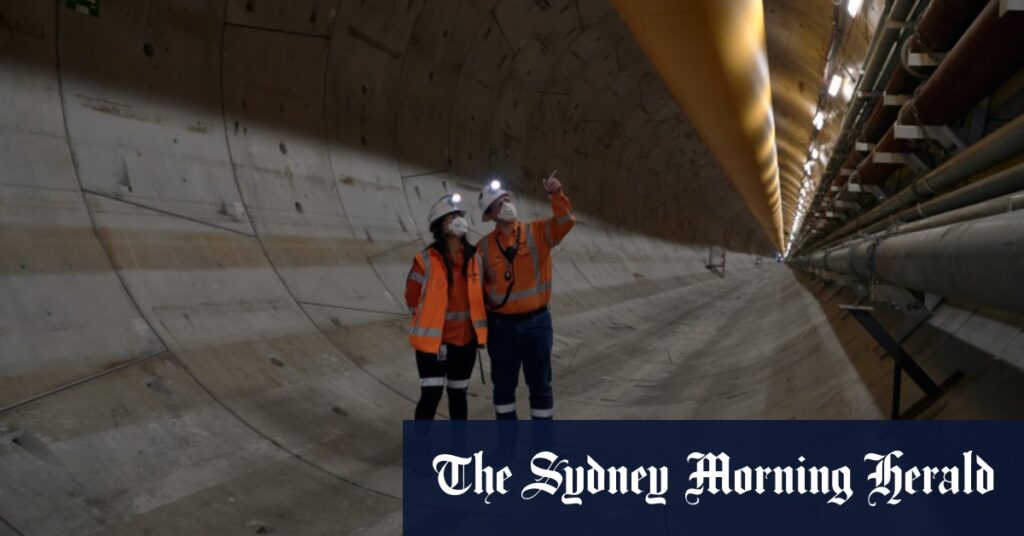Carving out Sydney’s second under-harbour rail crossing, two giant boring machines are performing intricate work despite their size, as one passes within five metres of the Anzac Bridge’s foundations.
A tunnelling machine named Jesse is slowly passing closest to the bridge after she was launched in late May, while another called Ruby is now starting her march eastwards from a massive hole dug for a station at the Bays precinct in the inner west on the $25 billion Metro West line.
Together, they will dig twin 2.3-kilometre tunnels stretching from the Bays station site to a stop at Pyrmont and onto a station at the northern end of the CBD, creating the second under-harbour crossing after the recently opened city section of the M1 line.
Metro West project director Daniel Powrie and Transport Minister Jo Haylen in one of the tunnels which will eventually extend to the Sydney CBD.Credit: Flavio Brancaleone
“It is precision engineering. There’s been zero movement of any asset above this tunnel or any of our tunnels,” Metro West project director Daniel Powrie said. “There’s constant monitoring of anything on the surface.”
Powrie said the harbour crossing was the biggest technical challenge for the Metro West project because of the Anzac Bridge and the shallow rock.
“We have to make sure we are far enough away not to influence the [bridge] pylons,” he said. “They are all different challenges, but it’s not the first time we have done these things.”
The giant rectangular hole dug for the Bays station is 27 metres deep, and parts of it are only about 20 metres from the harbour. The water’s proximity means it will have a similar design to the Barangaroo station on the city section of the M1 line which opened in August.
“You effectively have to make sure it doesn’t float. It’s like a big boat effectively, because when you put the station in, on the sides you have buoyancy,” Powrie explained.
“So you have to tie it down – very similar to Barangaroo. This is just a temporary box effectively for the tunnels. When the station contractor gets here, they’ll build the slabs and make sure it doesn’t float.”
In the walls of the giant station box, steel anchors as long as 70 metres have been rammed into the sandstone to act as stabilisers because of the ground conditions.
When it opens in 2032, the Metro West line will stretch underground for 24 kilometres between the Sydney CBD and Westmead, near Parramatta.
Transport Minister Jo Haylen said 420,000 people were expected to move into the Metro West corridor over the next two decades.
“It is our biggest public transport project. So much work has already taken place, and this is the last tunnel boring machine to be launched,” she said. “This new line will keep our growing city moving.”
The line is the fourth and largest stage of Sydney’s metro network, which is one of the world’s biggest rail projects, costing $65 billion. The expanded M1 line from Tallawong to Sydenham has recorded 10 million trips since the city section opened.
Known as mixed-shield slurry machines, Jesse and Ruby are specifically designed to excavate in highly pressurised conditions under the harbour, and are different to the four other tunnel borers which have been carving out other sections of the line.
Jesse and Ruby travel at about a third the speed of the others because of the combination of hard and soft rock they are encountering.
“It’s more about slow and steady tunnelling,” said Powrie, who has worked on Metro West for the past five years. “All engineering jobs change people’s lives, but you can see how this is going to change people’s lives forever.”
The second 1100-tonne machine that is just starting to worm eastwards from the Bays is named after women’s rights activist and Australia’s first radio astronomer, Ruby Payne-Scott.
In total, the two machines will remove 460,000 tonnes of spoil and install 16,536 segments by the time they finish the tunnels between the Bays and Hunter Street by late next year. Jessie has already excavated 615 metres and installed 2238 concrete segments to line the tunnel walls.
Loading
The seven-metre-wide rail tunnels will have a gradient of no more than 4 per cent to ensure that the driverless trains which eventually run along the line can climb from the deepest point, which is about 35 metres below the harbour surface. “The designs [of the tunnels] are there for passenger safety and comfort. You don’t want jolts, you don’t want ups and downs and sharps and lefts and rights,” Powrie said.
Excavation equipment has carved out almost two-thirds of the giant cavern for the station under Hunter Street in the CBD. It will be Metro West’s busiest station, handling about 35,000 people during peak periods.
Start the day with a summary of the day’s most important and interesting stories, analysis and insights. Sign up for our Morning Edition newsletter.
Read the full article here

